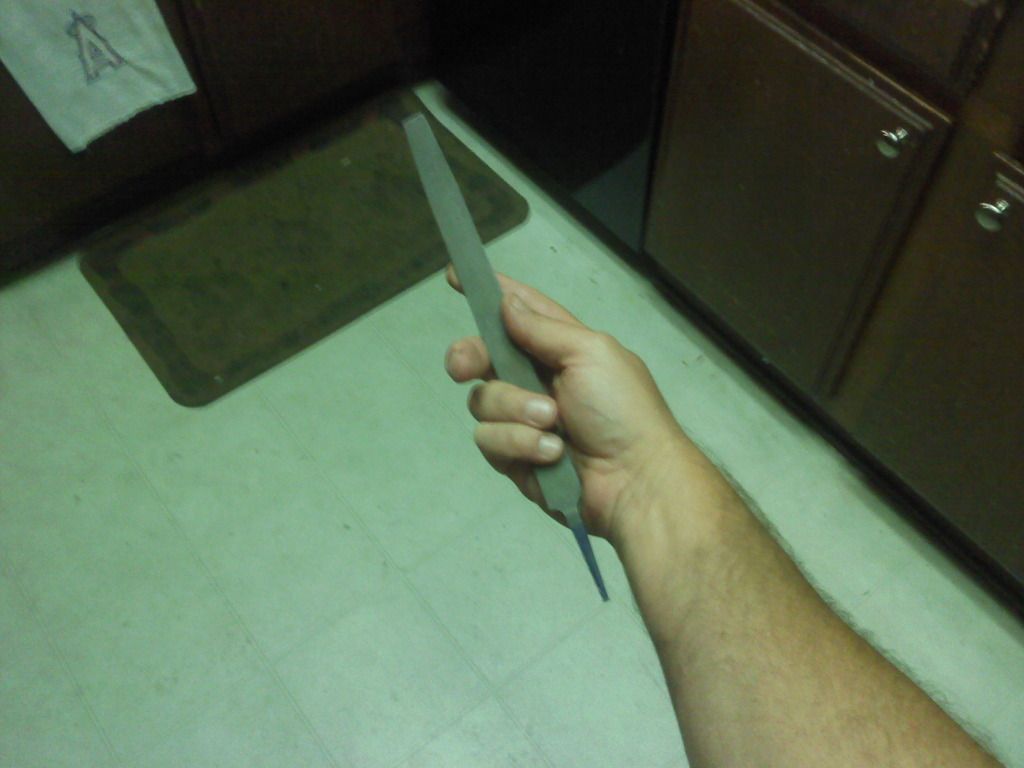-
Posts
312 -
Joined
-
Last visited
Content Type
Profiles
Forums
Articles
Gallery
Downloads
Events
Posts posted by Private Entrance
-
-
I built a table for my brake drum forge and it really made a huge difference in how well it worked. I didn't have to worry about overflowing, etc, and gave me a place to put a reserve of coal, things to cool, etc. I made the table out of an old bed frame and some sheet metal I pillaged from a washing machine a friend gave to me.
There are pictures of it in the thread 'Ghetto Forge Rebuild.' -
I used channel locks until I made my first couple of pair of tongs. Weren't the best for the job, but they worked ok. I never kept them in the fire, so melting wasn't an issue. They would get hot quick, so definitely wear a good glove on that hand.
-
Those are all very nice! Much prettier than any of the 2 1/2 pair I've made! (My 1st set of bolt tongs is about 1/2 way finished).
-
Phil, I like the idea of mounting the umbrella on your portable table. I'm getting near to the point of having enough stuff to move out tool-wise that carrying it out in armloads is getting old. A cart with wheels and an umbrella mounting would be just the trick.
-
Right on - that's an even more gooder idea - rigging the handle to double as a tool rack. I think that might work best as a 'here, hold this for a second' affair rather than a regular storage location, but either way it's worth some thought.
-
Think about wot it means when they say a 3/8" radius. Look at a piece of 3/4" round rod from the end..that is a 3/8" radius. A piece of 1/4" rod will show you a 1/8" radius. A lot of difference. If you already knew this maybe it will help someone else reading here.
Already helped me. ;) I had been thinking of edges as being a lot tighter than they actually are, by about half, I'm guessing, and I thank you kindly for that little lesson. -
Journey,
Don't mean to threadjack, but I'm getting ready to change my anvil stand from something like yours to a stump I just got ahold of. I had the thought of doing something very similar in terms of putting wheels and a handle on it to make it easier to move around. Does the handle in the picture come out of the holder fairly easily? I was considering pinning it in place with a bolt or something so I could get the handle out of the way when I'm working.
Thanks in advance.
I'm looking forward to seeing the suggestions for your shop build. I am thinking of doing something similar in the near future. -
If I have the image in my head right of how you are doing this, this is going to turn out extremely cool, and the error is only going to make it better, IMHO.
Can't wait to see how it turns out. -
Right on. Congrats. Forge welding is something I still haven't tackled yet.
Good luck on the knife! -
Thanks, Thomas. I was aware that riveted was stronger than not, but didn't think anyone was still doing it, much less that you could buy links that were pretty much ready to go. Very cool.
-
That's actually considered "closed" according to all the tutorials i've watched on youtube. as long as i get the two ends of the circle to line up completely, the links don't fall out
Roger - I was curious as to whether he was going to rivet the ends shut, which I understand is what was done to finish links on a 'working' set of chain, as opposed to just a 'Sunday-go-to-meeting' set. I understand you don't have to rivet them to keep the links together if you can get the gaps close enough. I wouldn't be surprised if few people go to the extra trouble of riveting them shut. -
That looks good. I've wanted to try making chainmail, but I'm afraid of the tedium. Are you going to close the links? Just curious, as that looks to be the most miserable part.
-
Absolutely brilliant. My 'good' stuff doesn't look that good.
-
Tang isn't anywhere near the palm of my hand. The base of the file sits right at the base of my thumb, and the tang sticks out beyond the bottom of my hand. If I'm really trying to remove material, I use a different tool - a panzar/body file, a rasp, or a scraper for wood and plastic, or a power tool for metal.
I'm beginning to think I use a file completely different from the way most of you guys do. I use one generally as a fit and finish tool, mostly for fairly precise work. The heaviest thing I might do with, say, a 10" mill file is put an edge or file a burr out of an axe blade. Heavier work on metal gets done with a heavier tool, preferably one with something else powering it other than elbow grease.
Here's a pic of the grip I use on a file from the 'underside' if you will. From here, I would roll my hand over palm down. The file would remain more or less running from about 10:00 to about 4:00. The file would cut from 6:00 to 12:00, with some movement along the line of the file itself. My left hand would be at the tip of the file for guidance and/or added pressure.
-
I've read some stuff on horseshoeing, and not only do you have to be pretty good with a hammer, you have to be able to deal with horses, and drive nails into their feet without laming the poor things. The little I know about it warrants some respect, and anyone that can feed their families with their head and their hands shouldn't be looked down upon, in my book.
The whole public confusion thing betwixt farriers and blacksmiths is part of the deal if you're going to do demos, etc. Something similar-ish used to happen to me at the ski area I worked at - I'd get asked at least 10 times where the bathroom is. Not in and of itself a problem, except for the fact that I was standing under a sign that said 'Bathroom - that way' in 12" letters. You can get pissed about it, or you can do a good turn and help sort someone out. Which is more likely to get you a sale, or get the next guy a sale when that person you dealt with runs into a smith again? -
I am old enough to remember those days, Frosty. :) Thems were the good ol' days, for sure.
I do have one file with a handle on it, that I inherited from my father in law. I was sharpening some axes for my son's scout troop a couple of nights ago, and put some thought into the whole handle/no handle thing. Using a file with a handle just feels... wrong. It just doesn't sit in my hand right. Like trying to write with the other hand or something. -
If I'm understanding your question right, it looks to me like they made the spike from the end of the arm the dishes sit on. The dishes look like they have a hole in them that lets the spike come through, and then the dishes look like the sit on top of an upset/bulge/collar on the arm.
That's what I see, anyway. Not that I know anything. I'm still a noob. ;) -
Frosty - that totally makes sense. We've been talking about apples and oranges the entire time. Thanks for clearing that up. :)
-
The 1/2" cold rolled round stock I made my spring fuller from cost me about $6.50 at Lowe's for a 36" length.
-
Putting a handle on a file has always felt like putting a sledgehammer handle on a scalpel and trying to do surgery. I can't feel what I'm doing when I have a handle on the file. Most of what I've done is hand sharpening or bevelling ski and snowboard edges - varying from 0-3*. Also, the handles tend to hit the ski/snowboard vises I'm using, or damage the base of the ski/board, especially when trying to make patches flush with the base.
Of all the tools that I've been injured by in a shop environment (usually due to operator error), files have never been one of them, whether a 6" mill/bastard or a 14" panzar/body file. The thought's never crossed my mind that it would be an issue. But then I've never done anything really (in my book) silly, like using a file to shape something on a high-speed lathe. In that case, if that were an acceptable practice (I have no idea, I'm not a machinist), then having a handle on the file would be a good idea in my book. -
I've used smallish (3'x6' or so) rubber mats in areas I stand frequently, like in front of workbenches or machines, and they are a lifesaver, especially if the alternative is concrete.
I worked in one shop where the entire floor was rubber matting. Nicest thing about that was that I could work in bare/sock feet if I had managed to get my feet wet shovelling snow and not freeze my toes off while my shoes dried. Mind you, this was a ski/snowboard shop, so I only had to worry about stepping in puddles or rolling a rack across my toes. I wouldn't recommend bare feet for anyone working hot metal. :) -
Three different guys, three different opinions... Tim likes wood handles, Tom likes golfballs, I currently despise handles of any sort.
It's the different opinions and experiences that make this group so much fun. The handles are one thing. You guys probably have a different tolerance than I do for solvents and plastic fumes - there's another. I know my knowledge of gas welding is limited enough that it scares the hell out of me, but you might consider it routine - yet a third.
I personally think we're better off with a friendly sharing our likes and dislikes (along with the reasons for them) than getting bent out of shape over them. I've worked in shops where everyone takes their own opinions so seriously that no one will listen to anyone else, and it ain't no fun.
But then again, what do I know? I'm still new. ;) -
I ground a flange to fit in the hole in the middle of a brake drum.
Cut two plates from the side of a washing machine
used the lug nut holes in the drum to bolt the flange in between the plates, with a hole in the bottom plate to allow a pipe to be run into the flange.
There are some pics of what I did in the 'Ghetto Forge rebuild' thread (currently on page 3) of the solid fuel forges. Hope it helps. -
I'll second Frosty on the spring fuller. VERY easy to make. I'm a complete noob, and I made one in about an hour. I looked at about 5-6 different ones, locked the concept in my head, and made one. And it was quite a bit of fun.


So I got my first hammer...
in Hand Hammers
Posted
Hand file would work better than sandpaper by hand. File to the shape you want it and polish out the file marks with the sandpaper.
Expect it to take a bit of work. Without power tools, it isn't going to be an easy task.